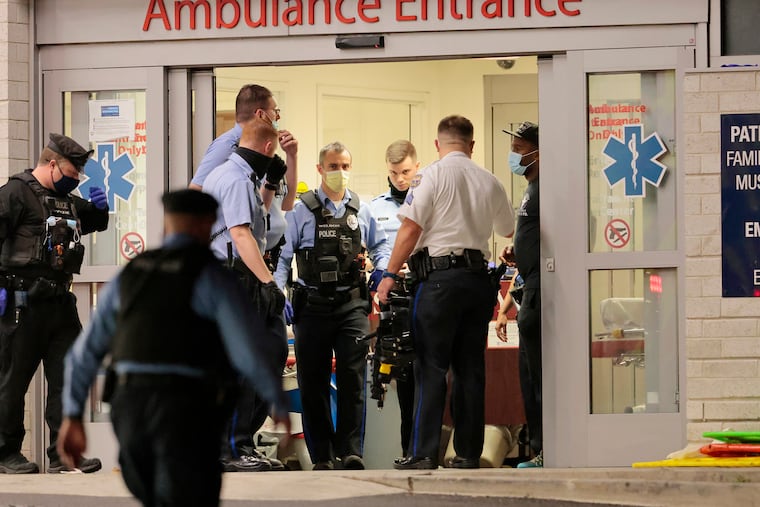Jefferson doctor: Do active shooter trainings do more harm than good? | Opinion
David Oxman at Jefferson Hospital, which experienced an active shooter last year, wonders if trainings shift our focus to managing, rather than preventing, a shooting in the first place.

The reminder comes to my email inbox every week from human resources. I have one more mandatory employee education module to complete.
Like most of my colleagues, I consider these annual online mini-courses — on topics such as medical radiation safety, billing compliance, or hand-washing — well-intentioned and of marginal benefit, something to be clicked through as quickly as possible while retaining just enough to pass the quiz at the end. A nuisance, to be sure, but nothing to get too riled up about.
This year, though, one of the presentations has me feeling uneasy. So much so, in fact, that I can’t bring myself to complete it.
The module, I know from years past, features a film produced by the Department of Homeland Security called “Run, Hide and Fight: Surviving an Active Shooter Event” and teaches you what to do if you are confronted with an active shooter in your workplace. It starts with a typical office scene — people working in cubicles, sipping coffee, and chatting around the water cooler – but layered over it is an ominous soundtrack. Cutting away from the office scenes, we see a man in dark clothes and sunglasses walking menacingly down the street. He enters the office, strides down the hallway, and casually starts picking off workers with rounds from the weapon he pulls from a backpack. Victims collapse in heaps on the ground, and as the simulated mass shooting unfolds, a narrator’s voice offers strategies for surviving a workplace massacre: Run, hide, and fight.
» READ MORE: The accused Jefferson Hospital shooter was found incompetent to stand trial, pausing his criminal case for now
The training film reminds me of something I watched many years ago: a short film from the 1950s called “Duck and Cover,” produced by the U.S. government. In this grainy, black-and-white time capsule, bobby-socked girls and Brylcreemed boys jump under school desks during a drill preparing them for a Soviet nuclear attack. All hoping, I suppose, that a few inches of wood desktop will somehow protect them from a thermonuclear blast. “Duck and Cover” was made at the height of the Korean War, when some U.S. leaders still considered the strategic use of nuclear weapons an option. Civilian training films prepared us for a nuclear attack and created the illusion of some level of safety where really there was none to be had. They tried to make the unspeakable manageable.
Today the threat of nuclear war persists, but in the United States at least, the biggest “unspeakable” risk is now death at the hands of a disaffected loner armed to the teeth rather than a mushroom cloud.
Late last year, my institution suffered an actual active shooter event. An employee, for unknown reasons, entered the hospital late at night carrying a gun, searched for and found a coworker, and murdered him at a workstation. I wasn’t in the hospital that night and I have no idea if any of the lessons taught to my colleagues in “Run, Hide, Fight” were called upon. Perhaps they were. But I wonder if these lessons provide any more cover than the Eisenhower-era desktops.
“Can we really expect training videos to reduce the body count if we can’t confront the flood of guns that soaks our nation?”
More important, I worry that these training videos shift our focus to managing, rather than preventing, a shooting in the first place. And I worry that when training videos on surviving a workplace shooting become as routine as videos about hand-washing and billing, each year the unspeakably abnormal becomes, little by little, just a bit more normal.
While I have no doubt that the administrator who assigned me the active shooter module has my best interests at heart, I want to remind them that no civilian training film ever prevented a death from nuclear war. Instead, it was diplomacy and disarmament guided by leaders that understood the true calamity of nuclear war that made the threat recede. Can we really expect training videos to reduce the body count if we can’t confront the flood of guns that soaks our nation? And in the long run, could trainings that make mass shootings appear manageable do more harm than good?
One day, I pray the training film sitting in my queue looks just as otherworldly and anachronistic to my children and grandchildren as “Duck and Cover” looks to me. Until then, the emails will keep coming.
David Oxman is an intensive care physician at Thomas Jefferson University Hospital in Philadelphia.